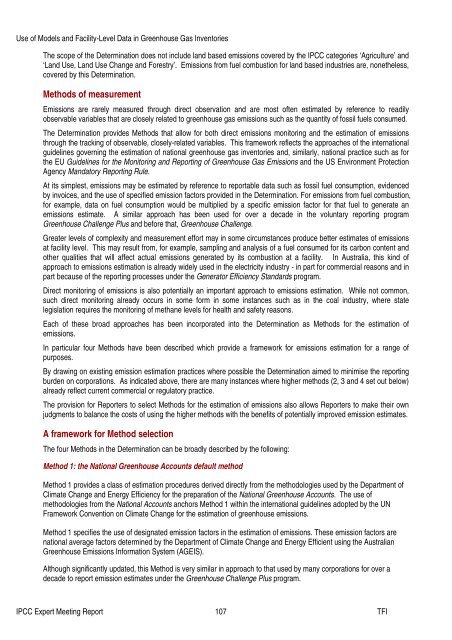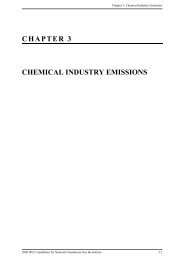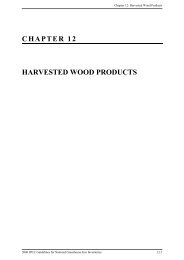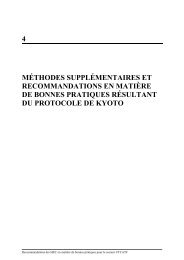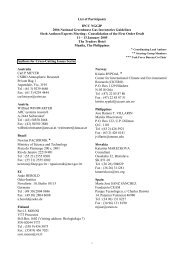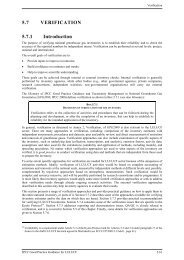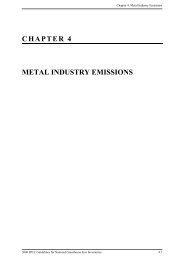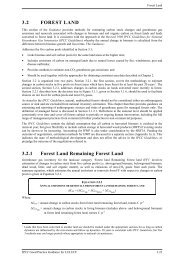Use of Models and Facility-Level Data in Greenhouse Gas Inventories
Use of Models and Facility-Level Data in Greenhouse Gas Inventories
Use of Models and Facility-Level Data in Greenhouse Gas Inventories
You also want an ePaper? Increase the reach of your titles
YUMPU automatically turns print PDFs into web optimized ePapers that Google loves.
<strong>Use</strong> <strong>of</strong> <strong>Models</strong> <strong>and</strong> <strong>Facility</strong>-<strong>Level</strong> <strong>Data</strong> <strong>in</strong> <strong>Greenhouse</strong> <strong>Gas</strong> <strong>Inventories</strong><br />
The scope <strong>of</strong> the Determ<strong>in</strong>ation does not <strong>in</strong>clude l<strong>and</strong> based emissions covered by the IPCC categories ‘Agriculture’ <strong>and</strong><br />
‘L<strong>and</strong> <strong>Use</strong>, L<strong>and</strong> <strong>Use</strong> Change <strong>and</strong> Forestry’. Emissions from fuel combustion for l<strong>and</strong> based <strong>in</strong>dustries are, nonetheless,<br />
covered by this Determ<strong>in</strong>ation.<br />
Methods <strong>of</strong> measurement<br />
Emissions are rarely measured through direct observation <strong>and</strong> are most <strong>of</strong>ten estimated by reference to readily<br />
observable variables that are closely related to greenhouse gas emissions such as the quantity <strong>of</strong> fossil fuels consumed.<br />
The Determ<strong>in</strong>ation provides Methods that allow for both direct emissions monitor<strong>in</strong>g <strong>and</strong> the estimation <strong>of</strong> emissions<br />
through the track<strong>in</strong>g <strong>of</strong> observable, closely-related variables. This framework reflects the approaches <strong>of</strong> the <strong>in</strong>ternational<br />
guidel<strong>in</strong>es govern<strong>in</strong>g the estimation <strong>of</strong> national greenhouse gas <strong>in</strong>ventories <strong>and</strong>, similarly, national practice such as for<br />
the EU Guidel<strong>in</strong>es for the Monitor<strong>in</strong>g <strong>and</strong> Report<strong>in</strong>g <strong>of</strong> <strong>Greenhouse</strong> <strong>Gas</strong> Emissions <strong>and</strong> the US Environment Protection<br />
Agency M<strong>and</strong>atory Report<strong>in</strong>g Rule.<br />
At its simplest, emissions may be estimated by reference to reportable data such as fossil fuel consumption, evidenced<br />
by <strong>in</strong>voices, <strong>and</strong> the use <strong>of</strong> specified emission factors provided <strong>in</strong> the Determ<strong>in</strong>ation. For emissions from fuel combustion,<br />
for example, data on fuel consumption would be multiplied by a specific emission factor for that fuel to generate an<br />
emissions estimate. A similar approach has been used for over a decade <strong>in</strong> the voluntary report<strong>in</strong>g program<br />
<strong>Greenhouse</strong> Challenge Plus <strong>and</strong> before that, <strong>Greenhouse</strong> Challenge.<br />
Greater levels <strong>of</strong> complexity <strong>and</strong> measurement effort may <strong>in</strong> some circumstances produce better estimates <strong>of</strong> emissions<br />
at facility level. This may result from, for example, sampl<strong>in</strong>g <strong>and</strong> analysis <strong>of</strong> a fuel consumed for its carbon content <strong>and</strong><br />
other qualities that will affect actual emissions generated by its combustion at a facility. In Australia, this k<strong>in</strong>d <strong>of</strong><br />
approach to emissions estimation is already widely used <strong>in</strong> the electricity <strong>in</strong>dustry - <strong>in</strong> part for commercial reasons <strong>and</strong> <strong>in</strong><br />
part because <strong>of</strong> the report<strong>in</strong>g processes under the Generator Efficiency St<strong>and</strong>ards program.<br />
Direct monitor<strong>in</strong>g <strong>of</strong> emissions is also potentially an important approach to emissions estimation. While not common,<br />
such direct monitor<strong>in</strong>g already occurs <strong>in</strong> some form <strong>in</strong> some <strong>in</strong>stances such as <strong>in</strong> the coal <strong>in</strong>dustry, where state<br />
legislation requires the monitor<strong>in</strong>g <strong>of</strong> methane levels for health <strong>and</strong> safety reasons.<br />
Each <strong>of</strong> these broad approaches has been <strong>in</strong>corporated <strong>in</strong>to the Determ<strong>in</strong>ation as Methods for the estimation <strong>of</strong><br />
emissions.<br />
In particular four Methods have been described which provide a framework for emissions estimation for a range <strong>of</strong><br />
purposes.<br />
By draw<strong>in</strong>g on exist<strong>in</strong>g emission estimation practices where possible the Determ<strong>in</strong>ation aimed to m<strong>in</strong>imise the report<strong>in</strong>g<br />
burden on corporations. As <strong>in</strong>dicated above, there are many <strong>in</strong>stances where higher methods (2, 3 <strong>and</strong> 4 set out below)<br />
already reflect current commercial or regulatory practice.<br />
The provision for Reporters to select Methods for the estimation <strong>of</strong> emissions also allows Reporters to make their own<br />
judgments to balance the costs <strong>of</strong> us<strong>in</strong>g the higher methods with the benefits <strong>of</strong> potentially improved emission estimates.<br />
A framework for Method selection<br />
The four Methods <strong>in</strong> the Determ<strong>in</strong>ation can be broadly described by the follow<strong>in</strong>g:<br />
Method 1: the National <strong>Greenhouse</strong> Accounts default method<br />
Method 1 provides a class <strong>of</strong> estimation procedures derived directly from the methodologies used by the Department <strong>of</strong><br />
Climate Change <strong>and</strong> Energy Efficiency for the preparation <strong>of</strong> the National <strong>Greenhouse</strong> Accounts. The use <strong>of</strong><br />
methodologies from the National Accounts anchors Method 1 with<strong>in</strong> the <strong>in</strong>ternational guidel<strong>in</strong>es adopted by the UN<br />
Framework Convention on Climate Change for the estimation <strong>of</strong> greenhouse emissions.<br />
Method 1 specifies the use <strong>of</strong> designated emission factors <strong>in</strong> the estimation <strong>of</strong> emissions. These emission factors are<br />
national average factors determ<strong>in</strong>ed by the Department <strong>of</strong> Climate Change <strong>and</strong> Energy Efficient us<strong>in</strong>g the Australian<br />
<strong>Greenhouse</strong> Emissions Information System (AGEIS).<br />
Although significantly updated, this Method is very similar <strong>in</strong> approach to that used by many corporations for over a<br />
decade to report emission estimates under the <strong>Greenhouse</strong> Challenge Plus program.<br />
IPCC Expert Meet<strong>in</strong>g Report 107 TFI


